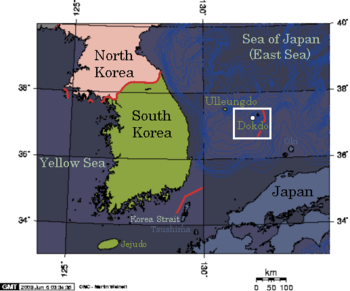CZ:Featured article/Current: Difference between revisions
imported>Chunbum Park m (→History) |
imported>Chunbum Park (→Digital rights management: Dokdo) |
||
| Line 1: | Line 1: | ||
== '''[[ | == '''[[Dokdo]]''' == | ||
---- | ---- | ||
{{Image|Map of Dokdo.png|center|350px|Coordinates: 37° 14´ N, 131° 52´ E<ref name="koreapdf">[http://www.korea.net/news/issue/attach/45_9095_1_en.pdf Part I: Profile of Dokdo]</ref>}} | |||
'''Dokdo''' is a small group of volcanic rocks located in the [[Sea of Japan]]. [[South Korea]] administers the islets as an area of the [[Ulleung|Ulleung County]], Northern [[Gyeongsang|Gyeongsang Province]]. The 46-acre formation consists of two main islands that house a lighthouse, a helicopter pad, and a small police force. Because Dokdo shelters a rich but delicate ecosystem, the government has designated the islets as a nature reserve and has provided environmental guidelines for the visiting tourists. The sovereignty over Dokdo has been contested by [[Japan]] over historical and legal grounds and remains one of the more serious disputes between South Korea and its former colonial ruler. Since at least 1905, the islands were called, in Japanese, '''Takeshima''' (竹島), meaning the "bamboo island". The Korean name has many different transliterations in English, including "Tok-do", "Dok-to", and "Tok Islets" (<span style="font-family: Batang, Serif">독도</span>), all of which equate to "rocky island". The islets have two English titles: '''Liancourt Rocks''' and '''Hornet Rocks'''. "Liancourt" has its origin in the name of the French whaling ship that first encountered and charted the islets in 1849. | |||
'' | ''[[Dokdo|.... (read more)]]'' | ||
{| class="wikitable collapsible collapsed" style="width: 90%; float: center; margin: 0.5em 1em 0.8em 0px;" | {| class="wikitable collapsible collapsed" style="width: 90%; float: center; margin: 0.5em 1em 0.8em 0px;" | ||
|- | |- | ||
! style="text-align: center;" | [[ | ! style="text-align: center;" | [[Dokdo#Notes|notes]] | ||
|- | |- | ||
| | | | ||
{{reflist|2}} | {{reflist|2}} | ||
|} | |} | ||
Revision as of 01:03, 10 August 2012
Dokdo
Dokdo is a small group of volcanic rocks located in the Sea of Japan. South Korea administers the islets as an area of the Ulleung County, Northern Gyeongsang Province. The 46-acre formation consists of two main islands that house a lighthouse, a helicopter pad, and a small police force. Because Dokdo shelters a rich but delicate ecosystem, the government has designated the islets as a nature reserve and has provided environmental guidelines for the visiting tourists. The sovereignty over Dokdo has been contested by Japan over historical and legal grounds and remains one of the more serious disputes between South Korea and its former colonial ruler. Since at least 1905, the islands were called, in Japanese, Takeshima (竹島), meaning the "bamboo island". The Korean name has many different transliterations in English, including "Tok-do", "Dok-to", and "Tok Islets" (독도), all of which equate to "rocky island". The islets have two English titles: Liancourt Rocks and Hornet Rocks. "Liancourt" has its origin in the name of the French whaling ship that first encountered and charted the islets in 1849.
| notes |
|---|
